25 Things to Do in Montmartre + Neighborhood Tour
Montmartre is one of the most representative neighborhoods of Paris, an absolute symbol of bohemian life and art of the 19th and 20th centuries. It is known, above all, for its squares painted by painters and for the dome of the Sacre Coeur Basilica (Sacré Coeur).
From impressionism in painting to the film Amélie Poulain and its soundtrack by Yann Tiersen, through the iconic song by Charles Aznavour, La bohème, the neighborhood and the arts go hand in hand and surround us at every corner.
It is a special neighborhood, with a magical atmosphere. Its cobblestones, its narrow and cozy streets, the different epochs that coexist in its urban layout, even its vineyards, make it, without a doubt, a very unique place.
And, of course, the memories of the golden ages of art, of war scenes from Roman times to the present day, passing through the Middle Ages, and historical moments in France such as the Revolution and the Commune.
Traces of everything can be found in Montmartre. So read on, and visit Montmartre on your trip to Paris!

Where is Montmartre Located?
Situated on a 130-meter hill in the 18th arrondissement, on the right bank of the Seine, the neighborhood is literally a world of sounds, senses, and landscapes in artistic harmony.
It is not for nothing that Montmartre is called by the locals “the artists’ quarter.”
The easiest way to get there is the subway and the closest stops are:
- Abbesses (This was the meeting point when we did the free tour of this neighborhood)
- Anvers (a few steps from here you can go up by the funicular or by stairs) We go up by the funicular, it costs the same as the metro and you can use the navigo, if you have it.
How Much Time to Spend in Montmartre?
As it is an entire neighborhood that covers many points of interest, the best way to visit it is to dedicate at least half a day.
That is, arrive at noon or early in the afternoon (at least: the neighborhood allows for more time).
We also recommend, to start, take a free tour. These types of tours have the advantage of giving us a panoramic view of the neighborhood, to later delve into what most attracts us about the place.
Before our list of things to see in Montmartre, a clarification, in case someone skipped this important information that bears repeating: Montmartre is a hill, so comfortable shoes are practically mandatory.
25 Things to See in Montmartre
Free tour of Montmartre
As we mentioned, to start, the best thing will be to take a free tour.
These tours have the advantage of being comprehensive, limited in time (2 hours and a half) and not having a fixed price, but at the discretion of whoever takes it according to the degree of satisfaction with it.
The tour will give us a snapshot of the most recommended neighborhood and some of its main attractions.
Place Blanche, the Moulin Rouge, rue Lepic and Café Deux Moulins, the building where Van Gogh lived, the Bateau Lavoir, the Maison Rose, the Basilica…
In addition, the free walking tours offer a wide range of time slots and have rich anecdotes that make the tour enjoyable, educational and, of course, interesting.

Visiting the Moulin Rouge
From 1889, when Montmartre was still a rural area surrounded by vineyards and sheep, to the present day, the Moulin Rouge has gone through several moments in its history.
Located at the foot of the hill of the neighborhood, in the same district, it is one of its main attractions.
Cabaret, theater, cinema, musical, pictorial, gastronomic, monument… At this point, there are no arts left outside the Moulin Rouge.
While touring, it is to breathe what remains of the atmosphere that inspired artists such as Henri de Toulouse-Lautrec or Auguste Renoir, there will also be those who, upon visiting it, remember the film starring Nicole Kidman: Moulin Rouge, love in red (2001).

Of course, the current Moulin Rouge retains its historical mystique despite having gone through fires and various reconstructions, as well as different uses according to contexts of the twentieth century (in World War II, for example, it was used as a dance club).
In any case, today, the Moulin Rouge is a visit that is as unavoidable as it is picturesque.
Its walls and its paintings preserve the atmosphere of its golden years and its current proposals combine gastronomic offers with its tradition of cabaret and musical spirit.
The hours for dinner with a show included start at 7:00 p.m. There are usually three gourmet menu options to choose from. It is advisable to get the tickets in advance.
As for the rates, they usually start at approximately 120 euros.
Mur des Je t’aime
Imagined by Frédéric Baron and Claire Kito and inaugurated in 2000, the Mur des je t’aime (I love you wall) is located in the square of the Place des Abbesses, on the hill of Montmartre.
Its access, as a work of art in public space, is free.
“The walls speak.” This saying could literally sum up this spot in Montmartre, which combines the artistic and multicultural uniqueness of the neighborhood with the romantic fame of the city.
We won’t say that Paris is the city of love because after films like Moulin Rouge, Amélie (2001), Before Sunset (2004) and Midnight in Paris (2011), among so many others, it would be practically a redundancy.
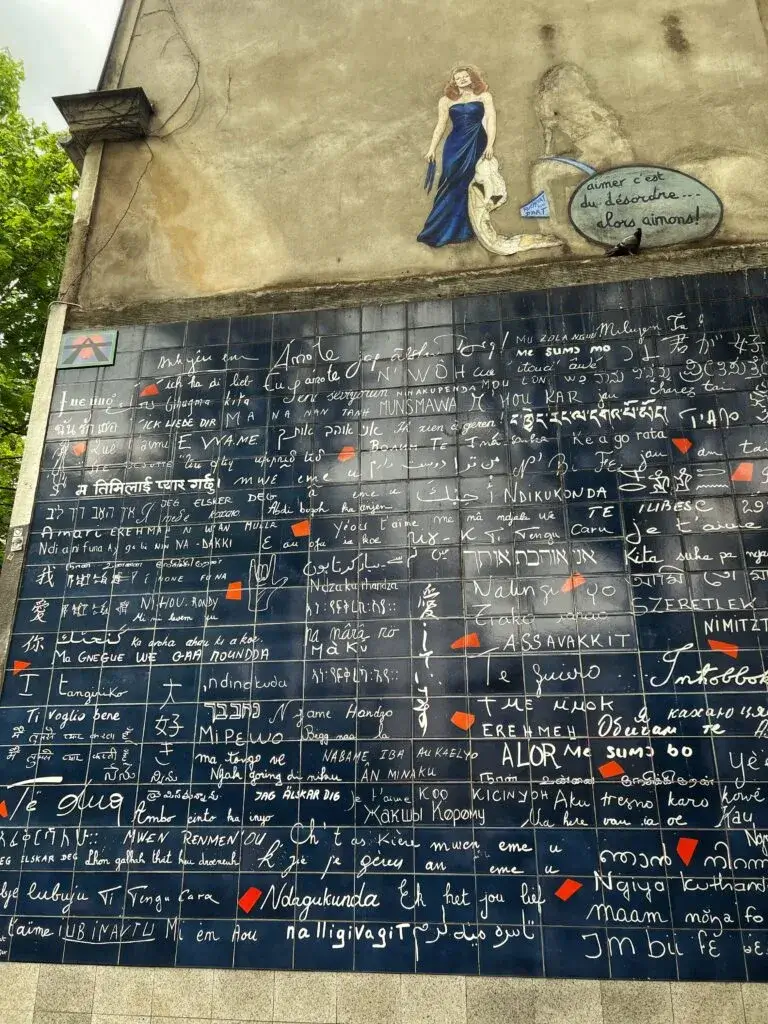
The truth is that the Parisian capital breathes romanticism and the Mur de je t’aime divides and unites, like love, in a spatial metaphor as simple as it is attractive.
It is a wall, and at the same time, it is about saying “I love you” in 250 languages, that is to say, to translate, to pass, to transmit from one language to another, from one person, one culture or way of being to another. A different wall in today’s world.
The wall covers an area of 40 m² and is made up of more than 600 enamelled lava tiles. In them, you can read 311 “I love you.”
In addition, here and there are scattered a few sparks of red that form the fragments of a broken heart.
It is idle to mention each of the 250 languages that appear on the wall. Watching it is an experience. It is a kind of hymn to love and multiculturalism made into a wall or mural, which is experienced by living it and having it in front of you.
READ 20 Romantic plans for Paris in winter.
Visiting the last vineyard in Paris: Clos Montmartre
Located on the Butte-Montmartre hill, the Clos Montmartre vineyards are made up, above all, of the classic varieties of the French wine-growing provinces.
You can access guided tours of the vineyards or appreciate them from the outside perfectly.
Montmartre was not always a neighborhood of Paris. It used to be an independent village, a rural, secluded place on the hillside next to the city. A landscape absolutely dissimilar to the current one, with windmills and vineyards.

That other era persists in the vineyards of Montmartre, designated as the last (or, at least, the oldest) in Paris.
They allow us to appreciate this facet of the region, urbanized towards the end of the 19th century and the beginning of the 20th.
If you visit Paris in October, you will find an ideal date to visit the vineyards, as the Fête des Vendanges de Montmartre (Montmartre Harvest Festival ), a tradition dating back to 1933, is celebrated at the beginning of that month.
Visiting the Sacre Coeur Basilica
Located on the hill of Montmartre, in Clignancourt, exactly at 35 Rue du Chevalier de la Barre, the Basilica of the Sacre Coeur is a point of religious, artistic and historical interest.
Its origin dates back to 1873, when its creation was decided by the National Assembly as an official way to honor the fallen in the Franco-Prussian War (1870-1871).

Its creation was not without political and spiritual controversy, but in 1875 construction began. The work of Paul Abadie was completed in 1914 and consecrated as a basilica in 1919.
The Basilica is imposing both for its dimensions and its context. Located on the hill of Montmartre, 130 meters high, it becomes doubly monumental. It is 83 meters long, 35 meters wide, and has a tower 83 meters high.
One of its main attractions, besides its crypt and its interior, is undoubtedly the dome, which can be climbed to get spectacular views of the city from the top of the neighborhood and its charming atmosphere.
The visit inside is free. And you know that, it may be difficult for you to find the Sacred Heart, when we were there, almost everyone overlooked it!
READ: Unique Places in Paris [SECRET].
Walking along the Rue de l’Abrevoir
Rue de l’Abrevoir is one of those narrow streets that have the particular charm of slowing us down and inviting us to stroll, contemplate and contemplate ourselves in its atmosphere of another time.
Narrow, cobblestone, cozy, framed by cinematic lampposts and with the dome of the Sacre Coeur emerging on the skyline of Parisian rooftops, Rue de l’Abrevoir is the perfect street to take beautiful pictures of our way through Montmartre.
Its name, which translates as “the street of the watering place,” dates back centuries and is due to the fact that it was the road taken to bring the animals to the watering place of Montmartre.

There are no more animals, no more watering hole, but the street retains that special calm.
In addition, the street has some unmissable points of interest, such as the Place Dalida (with the statue of the singer) and the Maison Rose (next stop), as well as being close to the vineyards of Montmartre.
As a tip or recommendation, we recommend taking this street when going to Montmartre on foot.
It is a really unique way of gradually accessing the neighborhood, with the dome of Sacre Coeur as a witness and the rising street that introduces us to the neighborhood.
Visit the Maison Rose
La Maison Rose (translated, Pink House) is located at number 2 Rue de l’Abrevoir. From the outside, you can see a modest pink house.
But, of course, appearances are deceiving. It is a famous house in the history of painting, today a restaurant.
The house dates from 1905, when the Catalan painter Ramon Pichot bought it. A friend of artists such as Dalí and Picasso, he built his house and studio there and received the most distinguished visits.
The house became famous for Utrillo’s painting at the beginning of the 20th century.
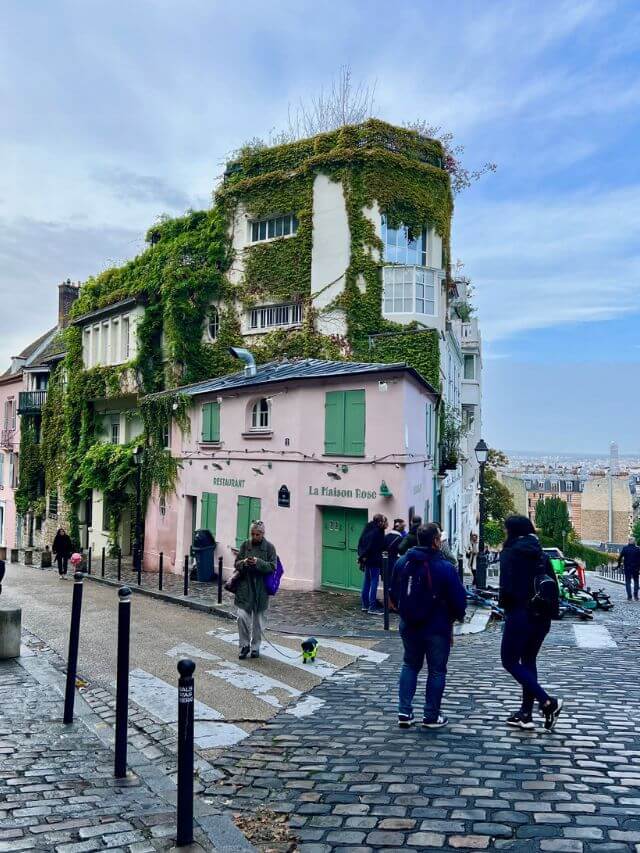
The history of the house throughout the twentieth century varied, with some mysteries during times of war, but it always remained an artistic landmark in the painters’ quarter.
Today, it accompanies the evolution of the neighborhood, from the artistic margin to the tourist center.
In case of going to eat, it is recommended to make a reservation in advance, otherwise it may become a setback or difficulty to access it. It usually opens at 12 noon.
It is possible to have lunch or a snack, although the offer for the latter is more limited.
Moulin de la Galette
Located at 77 rue Lepic, we find this postcard of rural times, vineyards and wheat fields: the Moulin de la Galette (Cake Mill).
It is a windmill that dates back more than three centuries and that, around 1870, began to be used as an open-air bar.
From there, it continued its history as a bar, dance hall or meeting place or inspiration for artists in Montmartre.

Undoubtedly, his glory came in the history of painting with Renoir’s canvas Bal du moulin de la Galette (Dance at the Moulin…), that Impressionist masterpiece whose original is exhibited at the Musée d’Orsay in Paris.
Musée d’Orsay The reproductions of which can be found in all kinds of contemporary buildings.
However, it not only inspired Renoir, but was also portrayed by artists such as Henri de Toulouse-Lautrec (Moulin de la Galette) and Vincent van Gogh (Le moulin de la Galette), among others.
As in the painting, this beauty cannot be entered: its interior is not open to the public and can only be seen from rue Lepic.
Place de Tertre, the square of the painters of Montmartre
If Montmartre is “the artists’ quarter” or “the painters’ quarter”, then the Place de Tertre (“Place du Montmartre”) is its iconographic place.
Famous for the portraitists and painters who exhibit and work outdoors, it is one of the most representative postcards of the Montmartre district.
The square is close to the Sacre Coeur Basilica and the Saint-Pierre de Montmartre church.

The Place de Tertre is a permanent temptation to the eyes, tempted to look and look.
As painting takes time and technique and is not the most beneficial for those who are on a walk, we recommend taking many photos.
The last time I was in Montmartre, this famous square was full of terraces from the surrounding restaurants and there were almost no painters left. A pity sees her
Having a drink at Amelie’s cafe
Café des deux Moulins (Café of the two mills). To continue with the tours of the rue Lépic, the mills, art and gastronomy, we recommend this well-known cafe for film lovers in general, and Amélie Poulain in particular.
Its name, “of the two mills”, is due to its proximity to the Moulin Rouge and the Moulin de la Galette.
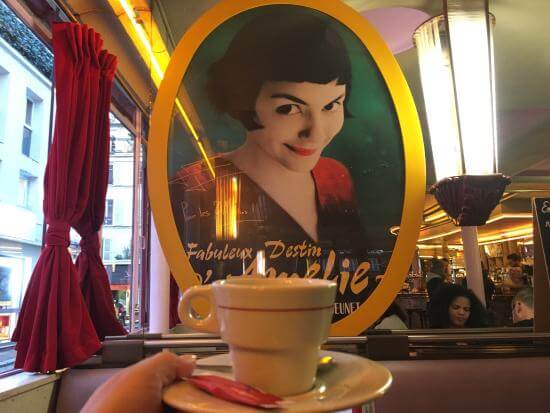
In this café, in fiction, the protagonist of the film works as a waitress and monologues about her thoughts. Since the film, it has been a total tourist attraction.
Of course, the place has its own particular charm beyond being a reflection of what was captured on film. As a brasserie, it is ideal for a snack and a rest between walks through the neighborhood.
Prices are affordable, and, in general, there is usually room.
Visit the Bateau-Lavoir
Located at 13 place Émile Goudeau, the Bateau-Lavoir is a historic building, famous for having been the residence of many artists in the Montmartre district.
Among the many others who lived there, Picasso, Gris, Modigliani, Matisse, Cocteau and Jarry stand out.
Of the residence of those historical painters of the 20th century, only the façade remains, mainly due to fires that took place in the 1970s of the 20th century.
It currently works as a residence for foreign artists and a few steps away you have the Montmartre museum.

Its name, which could be translated as “boat laundry,” is said to be due to an idea of Picasso and his colleagues, who saw in the façade a similarity to the boats moored on the banks of the Seine, used as washing places.
Walk along the Rue du Chevalier de la Barre
Pedestrian, varied, cobblestone, slippery: the rue du Chevalier de la Barre is a beauty that changes shape and routes as it moves forward or backward along its path.
To understand it, you have to see it on a map. It starts at 9 rue Ramey and ends at 8 rue du Mont-Cenis.
In its first part, it goes up to rue Lamarck and is pedestrianized. Then, from rue Lamarck to the intersection with rue de la Bonne, stairs give access to its highest point.
Finally, it becomes a street authorized for vehicles up to rue du Mont-Cenis.
It is named after Jean-François Lefèvre, the so-called “Chevalier de la Barre”, a young gentleman of the 18th century whose life was cut short at the age of 19, in 1766, amid accusations of sacrilege and blasphemy.
As fate would have it, after his brief and long-suffering existence, his figure has been vindicated and recovered to name a street after him. In its changing form, it seems to write in code, in the urban fabric, the changes in the shape of France from the 18th century until now.
Ride the Montmartre Funicular
The Funicular is not only a good option for days that are too hot or too cold, depending on who is traveling.
It is also a great option to see the route from another angle and, above all, to save time if necessary.
While we recommended walking up a few streets to gradually enter the Montmartre district, it can also be pleasant to avoid the 200 steps and climb in a minute and a half to the Basilica of the Sacré Coeur.
The Montmartre funicular is part of the urban transport of Paris. In other words, it costs the same as the Metro, and a T+ Ticket is necessary to access it.

Its schedule covers from 6 in the morning until 00:45 in the morning. It can be taken at Place Saint-Pierre.
Visit Dalida Square
Place Dalida, already mentioned in this post, is between rue de l’Abreuvoir, rue Girardon and Allée des Brouillards.
It is named after the Italian-French singer, actress, dancer, hostess and model who lived nearby, at 11 bis rue d’Orchampt.
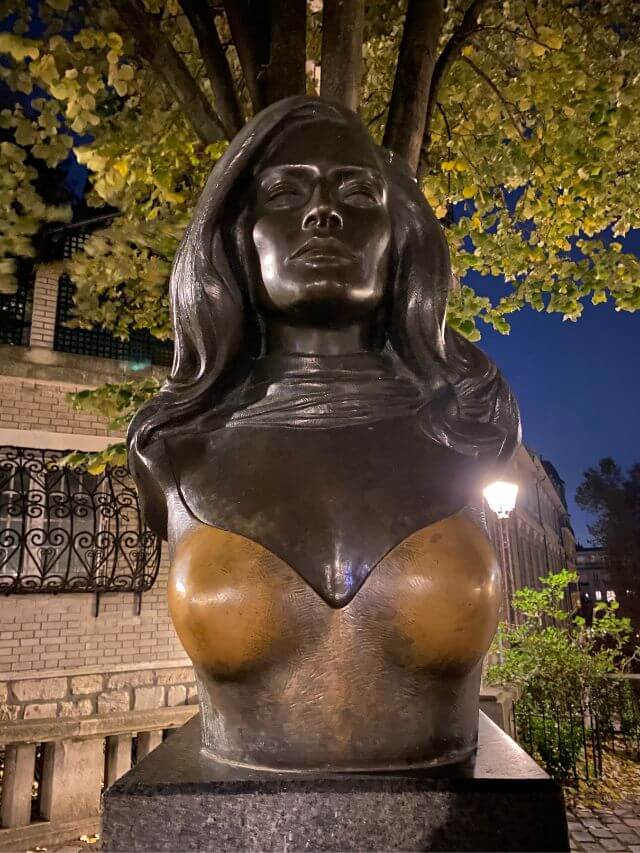
The bust of the singer created by Alain Aslan in 1996, almost 10 years after the singer’s death, her transformation into a French icon and the square’s becoming a place of pilgrimage, renamed in her honor that year, can be seen there.
Walk along the Boulevard de Clichy
The Boulevard de Clichy is almost 1 kilometer long, 42 meters wide and crosses the 18th and 9th arrondissements of Paris from Place de Clichy to Rue des Martyrs.
Also known as Boulevard des Martyrs or Boulevard Pigalle, the Boulevard Clichy is famous for its cafes and cabarets, both current and, above all, of the Parisian Belle Époque of the late nineteenth and early twentieth centuries.
Among the points of interest that stand out on the Boulevard, it is worth mentioning the Moulin Rouge, the café Le Chat Noir, Aux noctambules, among others.
Among them, they offer cafes with terraces, concert halls, tabacs, food stores and sex shops are mixed in a nocturnal line.
Close to the following metro Metro stations:
- Place de Clichy,
- Blanche
- and Pigalle,
- the Boulevard is a good place to make a connection with lines 2, 12, and 13 that serve it.
Grab a bite to eat at Le Consulat
Located at 18 rue Norvins in Montmartre, Le Consulat combines the current gastronomic offer with the historic building (one of the oldest in Paris) and the history of painting and art of the neighborhood.
Artistic and bohemian, cozy and even nostalgic, Le Consulat is a great place to grab a bite to eat while relaxing and soaking up the atmosphere.
Painters such as van Gogh, Picasso, Gauguin and Monet, among many others, gathered there. Nothing less.
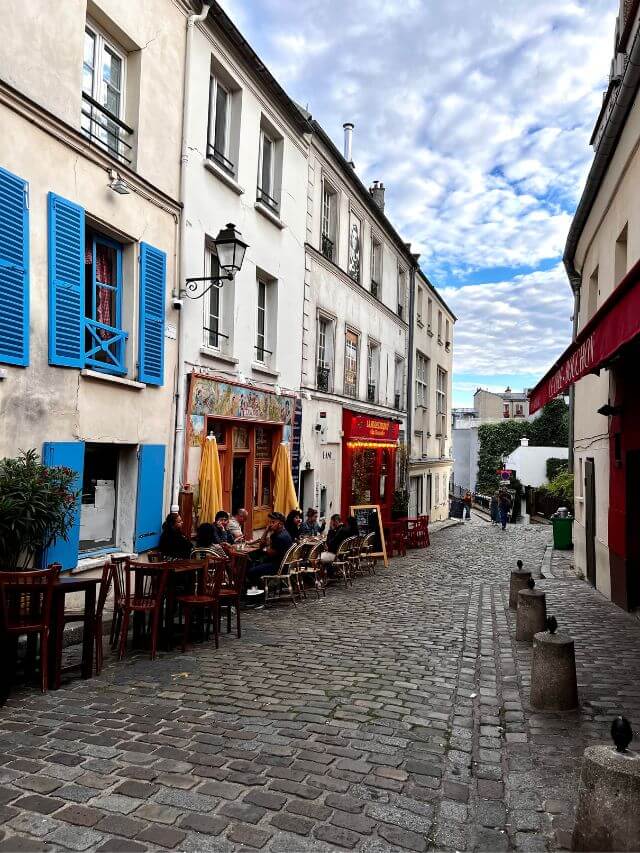
If we are lucky, our menu may be enlivened by a singer or guitarist and French songs. If not, it will simply be a beauty to sit and contemplate it and watch the movements of the neighborhood.
Take a picture of “The Sinking House”
“The Sinking House” could be translated as “the sinking house” or “the leaning house,” but keep calm, it has been said: it is an optical illusion, a matter of perspective. This is no coincidence since it is the painters’ quarter.
For lovers of eye-catching photographs, oddities, and bizarre shots, this is a must-see.
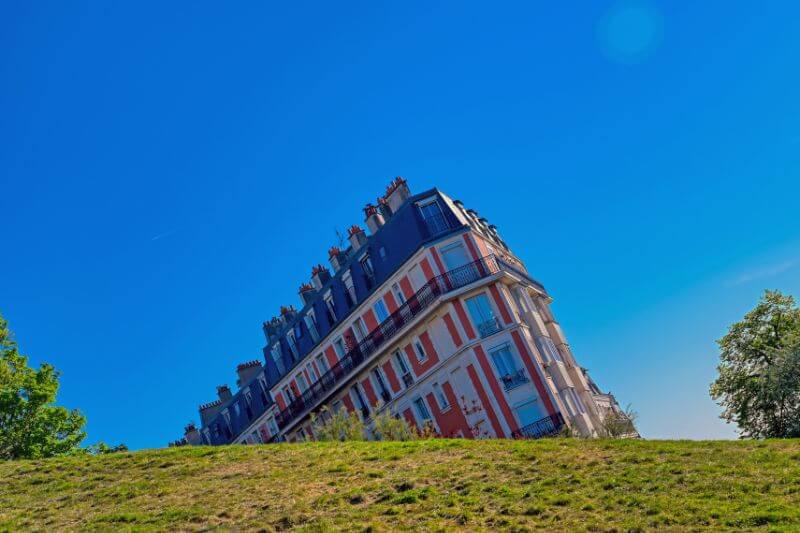
Near the Sacré Coeur Basilica, the “leaning house” takes advantage of the slope of the ground and its optical effects to be reproduced on all kinds of social networks as a prodigy worthy of the genius of Edgar Poe and the House of Usher.
Enjoy sunset views at Terrass Hotel
Sunset is always a magical moment if we have time to contemplate it. If, in addition to time, we have a well-equipped terrace for relaxation, it will be doubly charming. If finally, this is in Paris, then there is nothing more to ask.
This is possible at the Terrass Hotel.
Located on the butte Montmartre, the seventh floor of the Terrass Hotel is the one that gives the name to the whole place, not by chance: the view is simply magical and the place is perfectly set to enjoy.
With a bar and a restaurant with tables, umbrellas and padded swings, the terrace of this hotel is a must if you love panoramic photos, urban sunsets and the changing lights of that moment when the day changes its skin.
Like any outdoor location, the warmer the season, the more usable it will be. However, the view will always be worthy of a painting from the top of the art district.
Wave to the man coming out of the wall
In the Place Marcel Aymé, precisely on one of its walls, is this sculpture by Jean Marais that denotes movement and arouses both surprise and admiration: Le Passe-Muraille (the one who crosses walls).
The sculpture was inaugurated in 1989 but is inspired by Léon Dutilleul, a literary character published in 1943 by Marcel Aymé, who discovers one day that he has the power to walk through walls.
From there derive their adventures, their occurrences (stealing, running away) and their end.
Like many sculptures that attract travelers and tourists, like that of Delilah for example, it is rumored that whoever touches the Passe-Muraille returns to Paris one day.
Hence the brightness that stands out, precisely, from the contact with those who visit it.

Tour the Montmartre Museum
Located at 12 rue Cortot, the Montmartre Museum is open every day from 10 a.m. to 7 p.m.
It was created in 1960 in one of the oldest buildings in the neighborhood, where before, there were workshops and meeting places for numerous artists from the late 19th and early 20th centuries.
It currently houses paintings and drawings by Utrillo, Toulouse-Lautrec, Steinlen, Modigliani, among others.
To walk through it is to appreciate the artistic centrality that the neighborhood had in the Belle Époque, and to visualize how art and life were mixed in the nights of that time.
Iconic works such as Steinlen’s “Le Chat Noir Cabaret,” “Le Divan Japonais” or Toulouse Lautrec’s “Le Moulin Rouge” are exhibited there. You can also visit the Jardins Renoir that surround the museum and allow you to see the vineyards of Montmartre.
Discover the Montmartre Cemetery
At 20 avenue Rachel is the Montmartre Cemetery, open every day from 8 am to 6 pm, except on weekends, which opens at 8:30 am on Saturdays and 9 am on Sundays. In a neighborhood of artists could not miss a cemetery of artists. Here, is the proof.
When entering the cemetery, it is possible and advisable to obtain a map to locate the tombs of interesting personalities.
Among the many tombstones that we can find, the following stand out Degas, Stendhal, Truffaut, Dalida. From all the arts, there is someone.

Walk down rue Lepic and rue Norvins
Knowing a city or a neighborhood necessarily implies going through its streets and not only its points of interest.
Each street has its particularity, physiognomy, and contributes to the identity of the whole. In the case of Montmartre, Lepic and Norvins streets are definitely worth a walk.
The rue Lepic was an old road of Montmartre, turned street, where we will find attractions such as Amélie’s cafe (at number 13), the Moulin de la Galette (number 77) or Celine’s house (92), among others.

In fact, rue Lepic allows you to walk around it while you get to know the neighborhood and various other points of interest.
It starts at Place Blanche and ends at Place du Tertre. In other words, it goes from the Moulin Rouge to the painters’ square and the Sacre Coeur Basilica.
Rue Norvins runs from Abbesses Square to St. Peter’s Square. It has the particularity of representing very well the neighborhood to which it belongs. Cafes, terraces, galleries, stores of all kinds make it lively and bohemian.
Visit Montmartre on the Tourist Train
Les petits trains de Montmartre o Promotrain son unos trenes turísticos o “trenecitos” que ofrecen un circuito comentado por el barrio, con música incluida.
They usually last about 40 minutes and cost about €6.5. Your schedule: from 10 a.m. to 6 p.m.
In addition to the views of the neighborhood and the city, it allows having a panoramic view of the neighborhood in a relaxed and pleasant way.
The circuit goes from Place Blanche to Place du Tertre, passing by the Moulin Rouge, the Sacré-Coeur Basilica, the Montmartre Museum, among many other points of interest in the neighborhood.
Learn about the History of Lapin Agile
At 22 rue des Saules is Au Lapin Agile, a famous cabaret, one of the oldest in Paris. Open Tuesdays, Thursdays, Fridays and Saturdays from 9 pm to 1 am.
Immortalized by Picasso in his canvas of the same name, its story is curious and worthy of being heard on the free walking tour of Montmartre recommended above.
Visit the Museum of Romantic Life
The Musée de la vie romantique is located at 16 rue Chaptal. It is an 1830’s building that became a museum in 1982. Admission is free for permanent exhibitions (temporary exhibitions do charge admission).
Its story is linked to that of the Dutch painter Scheffer and, later, the writer Dupin de Dudevant, better known by his pseudonym: George Sand.
She lived there, Chopin’s neighbor and regular host to Delacroix, Lamartine, Dickens, among others.
Visit the Church of Saint Pierre de Montmartre
At number 2 rue Mont-Cenis is the Church of Saint Pierre de Montmartre, one of the oldest in Paris and a well-kept secret.
It dates from the 12th century, when King Louis VI, called “the fat one”, and his wife, Adelaide of Savoy, ordered it to be built.
Overshadowed or concealed, perhaps, by the splendor of the Sacre Coeur Basilica, the Church of Saint Pierre presents a laconic, neoclassical exterior, which makes it relatively discreet beyond the doors and their religious symbols and narratives.
However, the interior contains everything from the remains of temples of pagan gods from Roman times to the tombs of queens and religious stories such as that of Ignatius of Loyola, who is said to have taken his vows there with the Society of Jesus in the 16th century.

Best Time to Visit Montmartre
The neighborhood is a seasonal all-terrain, any season has its charm and aura because the space itself radiates it.
In case of very high or shallow temperatures, we will recommend to emphasize breaks and possible transportation to recover energy.
As for the scenery, whether it’s the brightness and sunshine over the vineyards or the gray of winter and the cold on the cobblestones, it doesn’t matter: the magic of Montmartre, its artistic epic, is enhanced at any time of the year.
What Montmartre is Famous For?
Montmartre is famous for the Sacre Coeur Basilica and the Place du Tertre, where painters and portrait artists work in the open air, adding to the historic aura of this artistic district.
Art, religion and history coexist with the rural past, windmills, vineyards, cabarets and cafés.
How to Get To Montmartre?
To get to Montmartre on foot, the best way is to get to Boulevard de Clichy, at the foot of the hill, and walk up the hill along rue Lepic or rue de l’Abrevoir, for example, to visit the points of interest.
If you opt for the subway, the following stations and lines will serve us: Anvers (line 2), Abbesses (line 12), Pigalle (lines 2 and 12) and Blanche (line 2).
Finally, the funicular. Same value as the metro, with a T+ Ticket, we can access it.
Its schedule covers from 6 in the morning until 00:45 in the morning. It can be taken at Place Saint-Pierre.

Stay in Montmartre
Staying in Montmartre can be attractive. The neighborhood, always lively, invites you to stay and come back.
As for the lodging offer, we can find numerous hotels or studios with highly variable prices.
Do not forget that it is Paris, and the price you will find depends a lot on the date you travel. Like everything, it’s a matter of searching.
Plan Your Trip to Paris
- 7-Day Paris Itinerary
- Tips for your first trip to Paris
- The best free walking tours of Paris
- What to take to Paris according to the weather
- The museums of the 16th arrondissement of Paris
- Secret places in Paris that you want to know

This post may include affiliate links. This means that we will receive a small fee if you make a purchase through our links. It has no additional cost to you. It’s a win-win!





